

When the thickness exceeds 5/8 (62.5%) of the spacing between two needles – after which sheet resistance needs more than 1% correction.

Q.How thick can a sample be and have it still be measured as a thin film, express in ohms-per-square? In other words, at what point is a sample so thick that it is no longer valid to measure it as a thin film?Ī.

Eng, M.I.Mech.E., F.B.H.I., Founder of Jandel Engineering Ltd. Sheet resistance (ohms-per-square) multiplied times the thickness of the material in centimeters, equals the volume resistivity (ohms-cm).Īnswers to questions, by John Clark, C. The following briefly explains how to calculate sheet resistance, volume resistivity, and thin film thickness if only two of these three properties are known. The sheet resistance of a given material will change depending on the thickness of the layer. The determination of what constitutes a thin film is based upon the relationship between one of the four point probe tip spacings and the thickness of the layer. Sheet resistance is expressed as “ohms-per-square” and it is used when measuring a layer or thin film of a semi-conductive material. Many materials that are thick or relatively large such as silicon ingots (as opposed to a thin film or layer), can be measured using a four point probe to determine the volume resistivity. The value in ohms-cm is the inherent resistance of a given material regardless of the shape or size. The term ohms-cm (“ohms centimeter”) refers to the measurement of the “volume” resistivity (also known as “bulk” resistivity) of a semiconductive material. & What Constitutes a Thin Film as Opposed to a Bulk Material? Based on the favorable findings of this limited application, the approach is deemed promising and viable, worthy of more in-depth examination.Calculating Ohms-cm, Ohms-per-square, or Sample Thickness When Two of the Three are Known It was also found that while the volume was relatively insensitive to the quantity and quality of the images used for the reconstruction, the computational time varied significantly from minutes to hours. It was found that the model-core volume was very close to that measured with a traditional liquid-displacement approach. This cloud is subsequently ‘meshed’ with planar polygons into a closed 3D shape and its volume calculated. Next, a demonstrative application is described, in which a field core is photographed from many viewpoints with a consumer grade camera, and the images are combined into a sparse point cloud. The paper presents the basics of image-based modeling, founded upon the science of photogrammetry and computer vision. It is based on calculating the bulk volume of the specimen in a three-dimensional model reconstructed from its images. An approach is explored for modernizing the determination of bulk density of compacted asphalt specimens.


 0 kommentar(er)
0 kommentar(er)
